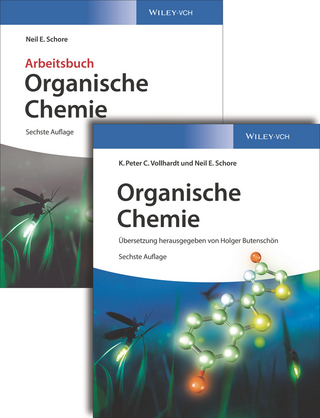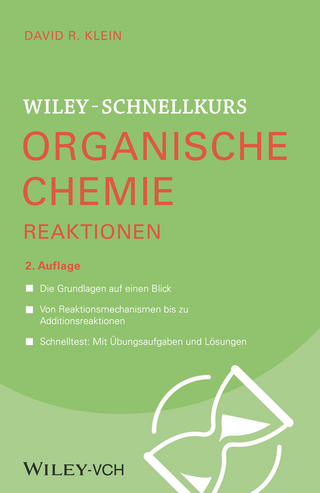
Electron Transfer Reactions in Organic Chemistry
Springer Berlin (Verlag)
978-3-642-72546-3 (ISBN)
I Electron Transfer, a Neglected Concept in Organic Chemistry.- I.1 Electron Transfer is Fundamental in Many Areas of Organic Chemistry.- I.2 Organic Electron Transfer Theories Come in Cycles.- I.3 References.- II Concepts and Definitions.- II.1 Electron Transfer Can Be Defined in Several Ways.- II.2 Inner-and Outer-sphere Electron Transfer.- II.3 Other Concepts in Electron Transfer Chemistry.- II.4 References.- III Theories of Electron Transfer in Organic Chemistry.- III.1 The Thermodynamic Approach to Electron Transfer Reactivity.- III.2 The Single Electron Shift, a Configuration Mixing Model of Electron Transfer Reactivity.- III.3 The Marcus Theory for Outer-sphere ET.- III. 4 Kinetic Models of Electron Transfer Mechanisms.- III.5 The Marcus Inverted Region.- III.6 The Rehm-Weiler and Agmon-Levine Equations.- III.7 References.- IV How to Use the Marcus Theory.- IV.1 Standard Potential.- IV.2 Reorganization Energy.- IV.3 Case Studies.- IV.4 References.- V Experimental Diagnosis.- V.l Phenomenological Approach.- V.2 Mechanistic Approach.- V.3 Summarizing Remarks.- V.4 References.- VI Reactions Between Organic and Inorganic Non-metallic Species.- V.1 Oxygen Derived Species.- VI.2 Sulfur Derived Species.- VI.3 Nitrogen Derived Species.- VI.4 Halogen Derived Species.- VI.5 Miscellaneous.- VI.6 Summarizing Remarks.- IV.7 References.- VII Reaction Between Organic and Metal Ion Species.- VII.1 One-and Two-electron Reagents.- VII.2 Choice of Metal Reagent and Substrate in Mechanistic Studies.- VII.3 Examples of Established Outer-sphere Mechanisms.- VII.4 Specific Systems.- VII.5 Conclusion.- VII.6 References.- VIII Electron Transfer Reactions Between Organic Species.- VIII. 1 Radical Ions and Radicals as ET Reagents.- VIII.2 Organic Ions and Even-electron Molecules as ET Reagents.- VIII.3 References.- IX Electricity and Light Promoted ET.- IX.1 Organic Electrode Processes.- IX.2 Photochemical ET.- IX. 3 Photoelectrochemistry.- IX.4 Chemiluminescence.- IX.5 References.- X Electron Transfer Catalyzed Reactions.- X.1 Electron Transfer Catalysis as a General Phenomenon.- X.2 An Overview of the ETC Process.- X.3 Different Types of ETC Reactions.- X.4 References.- XI ET and Polar Mechanisms; How Are They Connected?.- XI.1 Formulation of the Problem.- XI. 2 Electrophilic Aromatic Substitution.- XI.3 The SN2 Mechanism.- XI.4 Conclusions.- IX.5 References.- XII Applications of Outer-sphere Electron Transfer.- XII.1 Introduction.- XII.2 Photochemical Fuel Production.- XII.3 Light from Chemical Reactions (Chemiluminescence).- XII.4 Synthetic Applications of ET Reactions.- XII. 5 Conducting Organic Materials.- XII.6 Molecular Electronic Devices of Organic Origin.- XII.7 Oscillating Reactions.- XII.8 Wood Pulping and ET.- XII.9 Toxicity and ET.- XII.10 Degradation Mechanisms of Organic Compounds.- XII.11 References.- Epilogue.
| Erscheint lt. Verlag | 22.11.2011 |
|---|---|
| Reihe/Serie | Reactivity and Structure: Concepts in Organic Chemistry |
| Zusatzinfo | XIII, 234 p. |
| Verlagsort | Berlin |
| Sprache | englisch |
| Maße | 170 x 244 mm |
| Gewicht | 441 g |
| Themenwelt | Naturwissenschaften ► Chemie ► Organische Chemie |
| Naturwissenschaften ► Chemie ► Physikalische Chemie | |
| Schlagworte | catalysis • chemical reaction • Electrochemistry • Inorganic Chemistry • metals • Organic Chemistry • oxygen • synthesis |
| ISBN-10 | 3-642-72546-5 / 3642725465 |
| ISBN-13 | 978-3-642-72546-3 / 9783642725463 |
| Zustand | Neuware |
| Haben Sie eine Frage zum Produkt? |
aus dem Bereich


